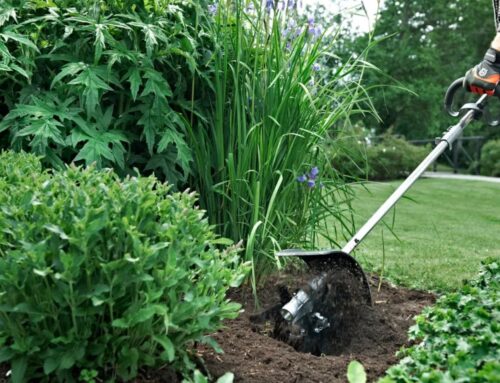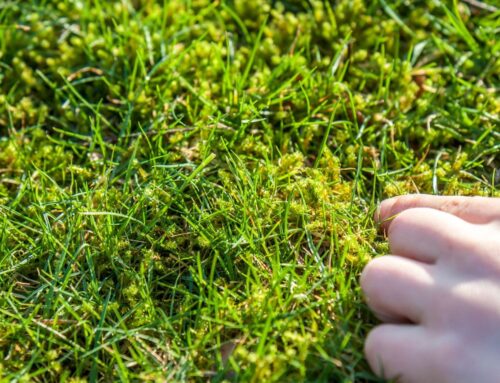
Our One-Stop Guide of How to Look After Trees in Your Garden
Trees add more than just beauty to a garden—they provide shade, improve air quality, support wildlife, and offer a sense of continuity. But despite their hardy appearance, trees do need care, especially in their early years or when grown in containers.
In this guide, we’ll explore how to look after trees in the ground, caring for trees in containers, and what to consider if you need to remove a tree. So, if you want to keep your trees healthy and thriving, pour yourself a cuppa and please read on…
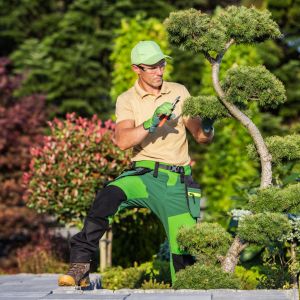 Maintaining Trees in the Ground
Maintaining Trees in the Ground
The first five years of a tree’s life are critical because they lay the foundations for the tree’s long-term success. While mature trees mostly fend for themselves, young ones need a little more support—and it starts from the ground up.
The Importance of Weeding
Firstly, you need to keep weeds at bay for at least the first three years. So, clear a one-metre ring around your tree that’s free of both grass and weeds because they will compete with the tree for water, nutrients, and light. The best ways to do this are through careful hand weeding or mulching.
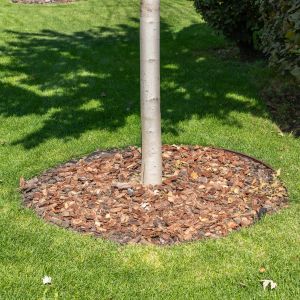 Mulch Is Your Trees’ Friend
Mulch Is Your Trees’ Friend
Mulched layers of bark, compost, or partially rotted woodchips do an excellent job of helping the soil around the tree retain moisture. Adding a 5-10cm mulch layer around the tree also helps with temperature control and mycorrhizal activity—beneficial fungi that support root health. Keep mulch away from the trunk itself to avoid rot, aiming for a doughnut shape around the tree. Reapply once a year as it breaks down.
Water Wisely
Once established, trees are best left to seek water for themselves. But in prolonged droughts—a growing concern in the UK—extra water may be needed. A good rule of thumb is one full watering can per week for every 2.5cm of trunk diameter. Deep, infrequent watering encourages stronger roots.
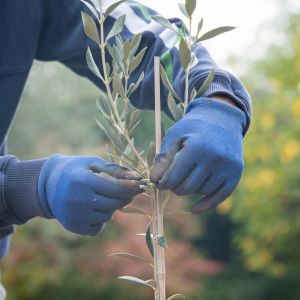 Don’t Forget the Stake
Don’t Forget the Stake
In windy areas or on open ground, young trees may need staking. Allow the trunk to flex slightly, which encourages strong growth, and regularly check that ties aren’t digging in. Once the tree can hold itself upright without support, it’s time to remove the stake.
Protect from Animals
Tree guards deter rabbits and rodents from damaging bark or nibbling shoots. Inspect these guards quarterly to check they’re stable and not harming the tree. You can start to remove them once the tree is well established but continue to monitor it for any signs of damage.
Prune with Care
Regularly inspect your trees for diseased, broken or damaged branches. In the case of deciduous varieties, pruning should wait until the tree is dormant—usually winter—when you can remove damaged limbs or competing leaders. Clean cuts just outside the branch collar will help the tree heal naturally.
How Can We Look After Trees in Containers?
Container-grown trees are ideal for patios, balconies, or small gardens. With the right care, they can thrive and bring fruit, seasonal colour, or evergreen interest to compact spaces.
 Picking the Right Tree
Picking the Right Tree
Dwarf or slow-growing trees do best in pots. Only pick faster-growing varieties if they are happy with vigorous pruning. Popular trees to grow in containers include acers, box, yew, and fruit trees.
Choosing the Best Pot
A container needs to be compatible with the size of the tree—so large enough to house the root ball with a bit of extra room for roots to spread. Avoid putting a small tree in an oversized pot; instead, pot up gradually. The container should have plenty of drainage holes too, as stagnant water can cause root rot. Frost-proof terracotta offers greater stability against wind, but the soil in them tends to dry quickly. Plastic pots are lighter in weight but retain moisture better. These are important things to consider when choosing the right pots for your trees.
 Soil Matters
Soil Matters
Avoid using soil from the garden in your containers. Not only is it more prone to weeds and insects, but it also compacts easily and retains too much water. Instead, use loam-based compost such as John Innes No. 3, which provides the necessary stability and nutrients. For acid-loving trees, choose ericaceous compost. Refresh the top layer of compost annually and feed every fortnight in summer with a balanced liquid fertiliser.
When to Water
Keep the soil moist—but not soggy. Container-grown trees dry out more quickly than those in the ground. Their foliage often blocks rain from reaching the soil, so check regularly and water deeply when needed. Even in winter, don’t let the compost become bone dry, especially during windy spells.
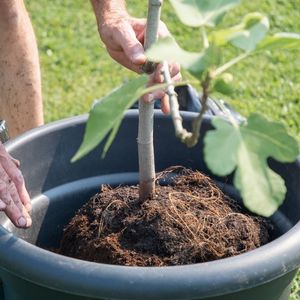 Protection from the Elements
Protection from the Elements
Container trees are more vulnerable to temperature extremes. So, in winter, wrap pots housing more tender specimens with horticultural fleece or bubble wrap to protect their roots. In summer, consider moving pots into dappled shade or using mulch to keep roots cool. Wind can be especially damaging to young or top-heavy trees, so keep them in a sheltered location wherever possible.
Rehome or Prune Roots?
After four to five years, potted trees may become root-bound. You can either rehome them in a larger container or lift the tree out, prune the roots, and return it to its original pot with fresh compost. This keeps the tree compact and healthy without needing to replant it in the ground.
How to Remove a Tree Safely
Sometimes, despite our best intentions, a tree needs to be removed. It may be diseased, dangerous, or simply unsuitable for its location. But before reaching for the chainsaw, there are some important things to consider…
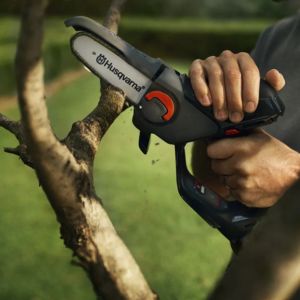 Check the Law
Check the Law
Trees visible to the public may be protected by a Tree Preservation Order (TPO), especially if you live in a conservation area. Removing or even pruning a protected tree without permission is a criminal offence. Contact your local authority’s Tree Officer to find out if consent is required.
Alternatives to Felling
If the tree is causing problems but isn’t dangerous, pruning or pollarding might resolve the issue. These methods can reduce height, remove diseased branches, and prevent future issues—without removing the tree entirely.
What About the Neighbours?
If a tree overhangs your garden from a neighbour’s land, you can legally cut branches back to the boundary—but you must not cross into their property or damage the tree. That said, it’s always best to discuss any potential pruning with them first. If the tree straddles both properties, you’ll need joint permission to prune or fell it.
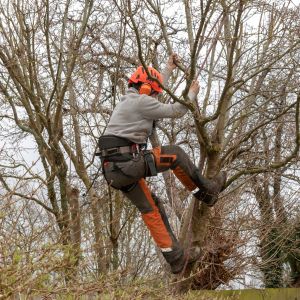 Use a Professional
Use a Professional
Tree removal can be dangerous work and is best carried out by a qualified arborist. They’ll assess the tree’s condition, plan safe removal, and ensure compliance with local laws. Here is the Arboricultural Association’s directory of certified professionals.
What to Do with the Stump?
After a tree has been felled, you’ll need to consider whether to leave the stump as a wildlife habitat or remove it completely. If removal is required, a stump grinder is the most effective tool for the job—especially when space is needed for replanting.
Replant with Purpose
If you have to remove a tree, consider planting another in its place. Choose a smaller, more manageable species that won’t outgrow the space. Native trees such as rowan, crab apple or hazel are great for supporting local wildlife.
The Right Tools to Look After Trees
 From routine pruning to full tree removal, if you need to look after trees, having the right equipment makes all the difference. That’s why Garden Machinery Direct stocks an outstanding range of professional-quality tools to help look after trees—whether they’re in pots or planted in the ground.
From routine pruning to full tree removal, if you need to look after trees, having the right equipment makes all the difference. That’s why Garden Machinery Direct stocks an outstanding range of professional-quality tools to help look after trees—whether they’re in pots or planted in the ground.
Explore our unbeatable selection of:
- Tree shears for fine shaping
- Pruning saws and loppers for branches
- Pole pruners for high or hard-to-reach limbs
- Chainsaws for heavier pruning and felling
- Stump grinders for clearing unwanted stumps
With decades of expertise and the UK’s best selection of garden machinery for sale, we are your one-stop online shop for tree care.
Maintaining trees doesn’t have to be difficult—just deliberate. Whether you’re nurturing saplings, managing mature trees, or saying goodbye to an old favourite, the right knowledge and tools go a long, long way.

